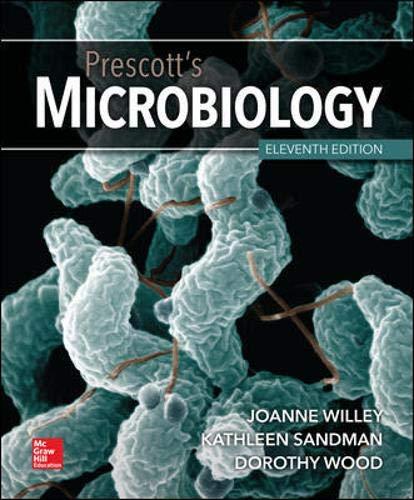
Prescott's Microbiology
11th Edition
ISBN: 9781260211887
Author: WILLEY, Sandman, Wood
Publisher: McGraw Hill
expand_more
expand_more
format_list_bulleted
Concept explainers
Question
Chapter 24.4, Problem 4CC
Summary Introduction
Any eukaryotic organism which is not a plant, animal, or
Expert Solution & Answer
Want to see the full answer?
Check out a sample textbook solution
Students have asked these similar questions
Protists are a group of eukaryotic organisms that are brought together by scientists mostly by convenience. I) What is the relationship between all protists that ties them together? ii) provide an example of a autotrophic and heterotrophic protists group, iii) what is the relationship between the multicellular eukaryotes and the protists?
What are mode of locomotion and general behavior especially differences between ciliate,flagellate, and amoeboid protists?
What material makes up a large proportion of a diatom’s cell wall?
What material makes up a large proportion of a diatom’s cell wall?
What are flagella?
What purpose do flagella serve?
What do euglenoids have instead of a cell wall?
What characteristics do plantlike protists share with plants?
How do euglenoids obtain food when there isn’t enough light to perform photosynthesis?
How do dinoflagellates compare and contrast with euglenoids?
How do algae get food to live?
Chapter 24 Solutions
Prescott's Microbiology
Ch. 24.1 - Prob. 1CCCh. 24.1 - Prob. 2CCCh. 24.1 - Prob. 3CCCh. 24.1 - Prob. 4CCCh. 24.1 - Prob. 5CCCh. 24.1 - Describe vesicular, ovular, and chromosomal...Ch. 24.1 - Why has taxonomic classification of protists been...Ch. 24.2 - Prob. 1MICh. 24.2 - What are the functions of the stigma and the...Ch. 24.2 - Prob. 1CC
Ch. 24.2 - What is the function of the plasmalemma and...Ch. 24.2 - Prob. 3CCCh. 24.3 - Prob. 1MICh. 24.3 - Prob. 2MICh. 24.3 - Prob. 1CCCh. 24.3 - Prob. 2CCCh. 24.3 - Prob. 3CCCh. 24.4 - Prob. 1MICh. 24.4 - What are the functions of the micronucleus and...Ch. 24.4 - How does the trigger for sexual reproduction...Ch. 24.4 - Prob. 1CCCh. 24.4 - Compare how radiolaria use axopodia with the way...Ch. 24.4 - Prob. 3CCCh. 24.4 - Prob. 4CCCh. 24.4 - Describe conjugation as it occurs in ciliates....Ch. 24.4 - Prob. 6CCCh. 24.4 - Prob. 7CCCh. 24.4 - Prob. 8CCCh. 24.4 - Prob. 9CCCh. 24.5 - Prob. 1MICh. 24.5 - Compare the morphology of members of the genus...Ch. 24.5 - Prob. 2CCCh. 24 - Prob. 1RCCh. 24 - Prob. 2RCCh. 24 - Prob. 3RCCh. 24 - Prob. 4RCCh. 24 - Prob. 5RCCh. 24 - Prob. 6RCCh. 24 - Protist encystment is usually triggered by changes...Ch. 24 - Vaccine development for diseases caused by...Ch. 24 - Prob. 3ALCh. 24 - Benthic foraminifera inhabit marine sediments. It...Ch. 24 - Prob. 5AL
Knowledge Booster
Learn more about
Need a deep-dive on the concept behind this application? Look no further. Learn more about this topic, biology and related others by exploring similar questions and additional content below.Similar questions
- What characteristic distinguishes most animal-like protists from otherprotists?arrow_forwardWhat are the major mechanisms of locomotion found in protists?arrow_forwardDescribe the morphology of oomycetes. Which protists are known for their cytoplasmic streaming movement? Which protists occasionally resemble tiny snails? What are the shells made of? Which group of protists have elaborate exteriors of glassy silica and are very common in the fossil record? What supergroup do land plants share a common ancestor with? What protists are common in tropical waters and are generally called “seaweeds?” Which of the algaes are the furthest living relatives to land plants? Which algaes are the closest living relatives to land plants? Which protists move using tube-like pseudopodia? Which protist group exhibits similarities to fungi as a result of convergent evolution? Which protist group takes on a slug form when nutrients are hard to come by? What protist group do animals share a common ancestor with? What are the choanoflagellates are believed to resemble? Which group contains at least one type of human parasite? Ecology of…arrow_forward
- How do protozoan protists do locomotion?arrow_forwardWhich of the following is not true of the protists? (a) they are unicellular, colonial, coenocytic, or simple multicellular organisms (b) their cilia and flagella have a 9 + 2 arrangement of microtubules (c) they are prokaryotic, as bacteria and archaea are (d) some are free-living, and some are endosymbionts (e) most are aquatic and live in the ocean or in freshwater pondsarrow_forwardWhat structure distinguishes rhizaria from all other protists?arrow_forward
- The internal structure of many protists is much more complexthan that of cells of multicellular organisms. Does thismean that the protist is engaged in more complex activitiesthan the multicellular organism is? If not, why are protistancells more complicated?arrow_forwardWhat advantage do you think a protist would gain by having a unicellular, filamentous, or colonial formarrow_forwardClapter 4. Define and identify properties of biofilms Familiarize yourself with the following structures and what purpose(s) they se o Glycocalyx (both slime layer and capsule) Fimbriae o Flagella, distinguish the different flagella arrangements axial filament sex pili cell wall plasma membrane inclusions ribosomes plasmids nucleoid chromosome o endospores What characteristics distinguish the Domain Archaea and Domain Bacteria? Regarding cellwall hp O o 0 O O 0 0 oarrow_forward
arrow_back_ios
SEE MORE QUESTIONS
arrow_forward_ios
Recommended textbooks for you
 Biology: The Dynamic Science (MindTap Course List)BiologyISBN:9781305389892Author:Peter J. Russell, Paul E. Hertz, Beverly McMillanPublisher:Cengage Learning
Biology: The Dynamic Science (MindTap Course List)BiologyISBN:9781305389892Author:Peter J. Russell, Paul E. Hertz, Beverly McMillanPublisher:Cengage Learning Biology (MindTap Course List)BiologyISBN:9781337392938Author:Eldra Solomon, Charles Martin, Diana W. Martin, Linda R. BergPublisher:Cengage Learning
Biology (MindTap Course List)BiologyISBN:9781337392938Author:Eldra Solomon, Charles Martin, Diana W. Martin, Linda R. BergPublisher:Cengage Learning

Biology: The Dynamic Science (MindTap Course List)
Biology
ISBN:9781305389892
Author:Peter J. Russell, Paul E. Hertz, Beverly McMillan
Publisher:Cengage Learning

Biology (MindTap Course List)
Biology
ISBN:9781337392938
Author:Eldra Solomon, Charles Martin, Diana W. Martin, Linda R. Berg
Publisher:Cengage Learning
Microbial Nutrition and Growth; Author: Scientist Cindy;https://www.youtube.com/watch?v=rK3UkyWjkl8;License: Standard YouTube License, CC-BY